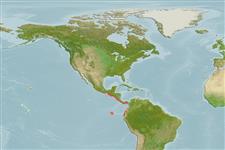Elasmobranchii (haaien en roggen) (sharks and rays) >
Carcharhiniformes (Ground sharks) >
Triakidae (Houndsharks) > Triakinae
Etymology: Mustelus: Latin for weasel, an ancient name for sharks, possibly referring to the pointed snouts, swift movements and/or rapacious feeding behavior of smaller predatory sharks [strictly not tautonymous with Squalus mustelus Linnaeus 1758 since type was designated by the ICZN]. (See ETYFish); dorsalis: Latin for “of the back,” referring to “projection of the posterior angle of the first dorsal fin to the vertical of the origin of the ventrals”. (See ETYFish).
More on author: Gill.
Environment: milieu / climate zone / depth range / distribution range
Ecologie
marien demersaal; diepte 20 - 200 m (Ref. 96339). Tropical; 20°N - 5°S
Eastern Pacific: southern Mexico to Peru.
Lengte bij maturiteit / Grootte / Gewicht / Leeftijd
Maturity: Lm ?, range 43 - ? cm
Max length : 64.0 cm mannelijk / geslacht onbekend; (Ref. 9253)
An inshore bottom-dwelling shark found on the continental shelves. Feeds primarily on shrimps and probably other crustaceans. Viviparous (with a yolk-sac placenta), with 4 young in a litter. Size at birth, 21 to 23 cm.
Viviparous, with a yolk-sac placenta (Ref. 244).
Compagno, L.J.V., 1984. FAO Species Catalogue. Vol. 4. Sharks of the world. An annotated and illustrated catalogue of shark species known to date. Part 2 - Carcharhiniformes. FAO Fish. Synop. 125(4/2):251-655. Rome: FAO. (Ref. 244)
Status op de Rode Lijst van het IUCN (Ref. 130435)
Gevaar voor de mens
Harmless
Gebruik door de mens
Visserij: van minder commercieel belang
Meer informatie
Leeftijd/GrootteGroeiLengte-gewichtLengte-lengteLengtefrequentiesMorfometrieMorfologieLarvenLarvale populatiedynamiekRekruteringAbundantieBRUVS
ReferentiesAquacultuurAquacultuurprofielKweeklijnenGeneticaElectrophoresesErfelijkheidZiektesVerwerkingNutrientsMassaconversie
Tools
Speciale rapporten
Download XML
Internetbronnen
Estimates based on models
Preferred temperature (Ref.
123201): 14.8 - 26, mean 16.6 °C (based on 31 cells).
Fylogenetische diversiteitsindex (Ref.
82804): PD
50 = 0.5000 [Uniqueness, from 0.5 = low to 2.0 = high].
Bayesian length-weight: a=0.00224 (0.00105 - 0.00478), b=3.14 (2.97 - 3.31), in cm total length, based on LWR estimates for this Genus-body shape (Ref.
93245).
Trofisch niveau (Ref.
69278): 3.6 ±0.55 se; based on food items.
Weerstandsvermogen (Ref.
120179): Zeer laag, minimale populatieverdubbelingstijd meer dan 14 jaar (Fec=4).
Fishing Vulnerability (Ref.
59153): Very high vulnerability (79 of 100).
Nutrients (Ref.
124155): Calcium = 36.2 [10.6, 179.4] mg/100g; Iron = 0.511 [0.153, 1.851] mg/100g; Protein = 20.7 [18.4, 23.0] %; Omega3 = 0.0958 [, ] g/100g; Selenium = 72.1 [21.3, 262.4] μg/100g; VitaminA = 18.2 [6.7, 48.0] μg/100g; Zinc = 1.12 [0.50, 2.28] mg/100g (wet weight);
